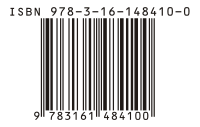Isbn
The ISBN (for International Standard Book Number) is a unique identifier for books. Through this system, each book is assigned a unique international alphanumeric string that serves to identify basic data of the object such as title, publisher, circulation, extension, subject, country, translator, original language, etc. It should not be confused with the ISSN (International Standard Serial Number, in Spanish "Número Internacional Normalizado de Publicaciones Periodicals"), which corresponds to periodical publications, such as magazines and diaries.
Description
The ten-digit ISBN
It was created in 1970 by adopting the international standard ISO 2018, until the reform that came into force in 2007, each edition and variation (except reprints) of a book received an ISBN composed of 10 digits in length, and divided in four parts:
- the country code or language of origin,
- the editor,
- the number of the article and
- a control digit.
These parts have different lengths and, to improve their readability (human readability), it is recommended, but not required, that they be separated by whitespace or hyphens. Also, prefixes are used to ensure that no two codes can start the same way.
If used, it has to be positioned correctly, the first hyphen was placed after the first digit, the second hyphen was variable placement, and the third hyphen after the ninth, just before the check digit.
The country code was 0 or 1 for English-speaking countries, 2 for French-speaking countries, 3 for German-speaking countries, etc. The original ISBN system lacked the country code, but prepending a 0 to a 9-digit SBN number created a valid ISBN. The country code can be up to 5 digits long; for example, 99936 is used for Bhutan. You can consult the list of ISBN by country.
The publisher number is assigned by the national ISBN agency, and the article number is chosen by the publisher.
Publishers receive larger ISBN blocks than they are expected to need; a small publisher may receive ISBNs consisting of one digit for the language, seven digits for the publisher, and a single digit for individual articles. Once you finish that block you may receive another one, with a different publisher number. Therefore, sometimes different publisher numbers actually correspond to the same publisher.
The check digit of a ten-digit ISBN is found by a calculation based on modulo 11: Multiply each of the first nine digits by the position they occupy in the numerical sequence, that is, the first by 1, the second by 2, and so on until the ninth, which is multiplied by 9. Then these multiplications are added and the result is divided by 11. Said division will leave a remainder between 0 and 10. If the remainder is between 0 and 9, this same value is the check digit. But if the remainder is 10, then the letter X is set as the check digit.
The thirteen-digit ISBN
Due to shortages in certain ISBN categories, the International Standards Organization adopted the implementation of a thirteen-digit ISBN from January 1, 2007. This update brings the ISBN system on par with the ISBN code system. EAN bars. Existing ISBNs are prefixed with "978" (and the check digit will be recalculated); when ISBNs “978” are exhausted, the prefix 979 will be introduced. It should be noted that the publisher identification numbers assigned in ISBNs “978” and “979” are unlikely to match.
The check digit of a thirteen-digit ISBN is calculated in a different way than a 10-digit ISBN, with a calculation based on modulo 10: multiplying the first of the 12 initial numbers by 1, the second by 3, the third by 1, the fourth by 3, and so on until reaching number 12; the check digit is the value that must be added to the sum of all these products to make it divisible by 10 (for example if the sum is 97, the check digit is 3, because 97 + 3 = 100, which is divisible by 10; if the sum is 86, the check digit will be 4; if they add to 120, it will be 0; and so on otherwise).
Many publishers, including Barnes & Noble, have chosen to use ISBNs. But many retailers prefer the more universal European Article Number (EAN) standard, as it applies to all media, not just books.
Bookland
Bookland is the informal name for the Unique Country Code (UCC) prefix assigned in the 1980s to European Article Number (EAN) identifiers of published books, regardless of country of origin, so the EAN namespace can maintain a redundant parallel numbering system. In other words, Bookland is a fictitious country that exists solely in EAN for the purpose of geographically cataloging books in the EAN coding system, which would otherwise have a geographic key.
Similar systems
- ASIN: Amazon Standard Identification Number or ‘Amazon’s Standard Identification Number’.
- ISMN: International Standard Music Number or ‘International Standard Musical Number’.
- ISAN: International Standard Audiovisual Number or ‘International Standard Audiovisual Number’.
- ISSN: International Standard Serial Number o ‘Normalized International Number of Periodical Publications’, which is used in periodicals, such as journals and newspapers.
- IBSN: Internet Blog Serial Number or ‘Number Series of Internet Blogs’.
Contenido relacionado
Oxford
MediaWiki:Nowiki sample
Optical pencil
